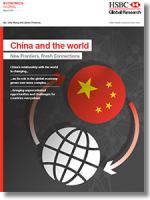China and the World: New Frontiers, Fresh Connections
China's role in the global economy keeps expanding, and over the past 25 years, it has gone from 11th largest to second, the country’s economy is now 60% that of the US, and that means its role in determining global demand is critical, however, China’s relationship with the world is changing, this report sets out to examine these changes and what they mean for China and the rest of the world.
The patterns of China’s overseas direct investment are changing rapidly.
Investors started with raw materials but, having moved on to infrastructure and manufacturing, are now focusing on big-name consumer brands and high-tech companies.
Chinese direct foreign investment, once dominated by large state-owned enterprises in search of iron ore and copper, now features private-sector giants buying US film studios and European fashion houses, alongside state-backed companies snapping up new technology firms.
Direct investment overseas exceeded foreign investment into the country for the first time in 2015. China also overtook Japan to become the world’s second largest provider of overseas investment.
Non-financial direct investment abroad by China grew 54 per cent in the first nine months of 2016 to USD134 billion, surpassing the USD121 billion for the whole of the previous year, which was driven by the ‘One Belt, One Road’ initiative to recreate the ancient Silk Road – the overland and maritime trading route connecting Asia and Europe.
One Belt, One Road: With the Silk Road Initiative, China Aims to Build a Global Infrastructure Network
Infrastructure is the key physical component of the Silk Road initiative, including railways, roads and ports. But while China has invested heavily in infrastructure in recent years, investment in manufacturing has now accelerated. Beijing’s aim is to upgrade its domestic industry by internationalising it. Manufacturing outsourcing more than doubled in 2015 with machinery manufacturing increasing 154 per cent.
Beijing is promoting international co-operation on industrial production and equipment manufacturing, identifying 12 sectors – steel, ferrous-metal, building materials, railway, electricity generation, chemical, textiles, automobiles, telecoms, engineering machinery, aerospace, ships and offshore engineering – where China has competitive advantages and global demand is strong.
High-speed trains, railways and nuclear power are China’s new global industrial calling cards. Railways in Indonesia, Thailand, Laos and Europe are all entering the implementation stage. Nuclear power equipment and technology have been exported to Pakistan, the UK, Argentina and South Africa.
Download China Trade Operations: Trends and Advancements
After initial heavy investment in sub-Saharan African transport networks, China is now focusing on Europe, West and East Asia plus the Middle East and North Africa.
Corporate acquisitions are also part of this evolution and private-sector companies accounted for 65 per cent of overseas direct investment during the first nine months of 2016
The New Silk Road remains important though. There are more than 900 projects in the pipeline with an investment value totalling USD800 billion, mostly involving infrastructure, plus, 29 rail lines to Europe starting from 17 Chinese cities. This should help increase the region’s future trade and investment flows.
And two government-led financial institutions – the Silk Road Fund and the Asian Infrastructure Investment Bank – are now fully operational.
So, with the global economy showing signs of recovery, more Chinese projects are reaching the implementation stage, cross-border connections are becoming more sophisticated, and financing support is gradually strengthening. China’s investment in the New Silk Road region should grow at a stable pace in the next couple of years.
About the Author
Qu Hongbin is Managing Director, Co-Head of Asian Economics Research, and Chief Economist for Greater China at HSBC. He has worked in financial markets for over 20 years, the past ten at HSBC. Hongbin is also a deputy head of research at the China Banking Association.
China, Trade, and the World
What’s Related

Favorites







